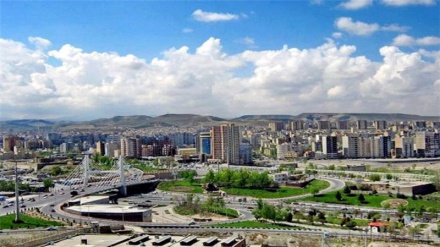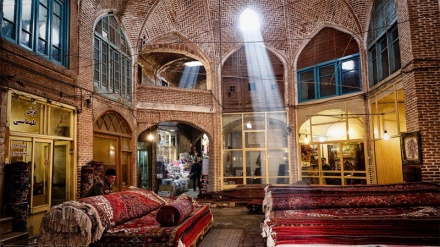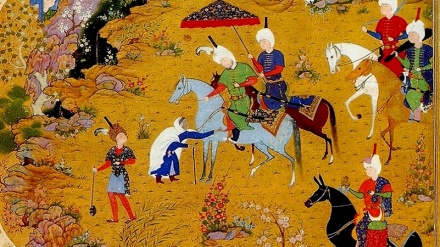Tabriz, 2018 (12)
Tabriz is a beautiful and historical city, and is home to numerous unique historical, cultural, and religious sites. The memories of this city are etched in the minds of those, who visit this popular tourist destination.
One of the most important feats of the Islamic architecture and tourist attraction sites of the city of Tabriz is Masjid-e Kaboud. The majority of tourists who visit this city have heard of the beautiful tiling, and richness of colors of this historical monument, beforehand. This glorious monument was enlisted among Iran's national heritages in the year 1931 AD.
Masjid-e Kaboud is covered with turquoise- and blue-colored tiles; works of calligraphy; and unique geometrical designs, which have captured the attention of art-lovers all over the world. The construction of this historical mosque dates back to the 9th Century AH, and the year 870 AH.
In the past, this building was part of a complex; comprising of edifices such as a school, a mosque, and a library. Unfortunately, only a part of the mosque, which has been severely damaged, has remained to this day. This mosque has had a number of different names throughout the course of history.
Upon entering the mosque's courtyard, the beauty and grandeur of this historical monument meets the eye. A combination of colorful bricks and tiles, used in the construction of the mosque, has led to creation of an eye-catching building.
The architect of this mosque has established an appropriately compatibility between this edifice and the climate of the city of Tabriz, such that all of the different sections of this mosque have been functional, all year long.
Upon entry to the mosque, the difference of temperature in and out of the mosque is highly tangible, such that throughout the warm summer days, the temperature inside the mosque is moderate, which coupled with the spiritual atmosphere in the mosque, results in the worshippers' peace of mind. By standing underneath the very large dome of this mosque, and glancing at the mosque's tall ceiling, you will experience a completely different feeling.
Throughout the horrific quake, which rocked the city of Tabriz in the year 1193 AH, the mosque was severely damaged and its dome collapsed. Nonetheless, the remains of this mosque still manifested the glory and unique art of this mosque. The reconstruction of the dome of this mosque was carried out by late Reza Me'maran, and its inner and outer tiling is underway.
This mosque maintains a square-shaped courtyard, a large pond for ablution, and attractive roofed sections, on the sides. The main building of the mosque, which is square-shaped, was previously covered with a brick-made dome.
If one looks at the surroundings of the roofed sections of the mosque; works of calligraphy, depicting ayahs of Holy Quran can be observed.
Beautiful tiles cover the surface of the wall on top of the main door, coupled with an inscription which dates back to 870 AH. This inscription, in addition to a number of other inscriptions which have been installed on the top of the main door of the mosque are the works of the famous calligrapher of 9th Century AH, Mr. Nematollah al-Bavab.
The main roofed section of the mosque is surrounded by balconies on three sides, and is covered with a double-layered dome, with an approximate diameter of seventeen meters. The smaller roofed section is situated in the southern corner of the building. Its tiles are blue in color, and are mainly comprised of hexagonal pieces; parts of which have remained intact to this day. The surface of the ceiling had most probably been entirely covered with paintings and the floor of the roofed sections had likely been covered with marble stones.
According to one of the professors of the University of Tabriz; the grandeur and beauty of this historical mosque is such that tourists including Chardin have visited this historical edifice in the past six centuries, and have spoken of the grandeur and uniqueness of this huge mosque.
One of the contemporary researchers points out that the majority of sources of information and travelogues have pointed out that this mosque was constructed throughout a course of thirty years.
Another tourist attraction site of the city of Tabriz is "Asr-e Aahan" Museum, within which many skeletons, dating back to up to 4,000 years ago, who have been buried with their valuable ornaments, are on display. The age-old background of these works have granted global value to this museum. This museum was launched in the year 2006. The majority of the works, identified and displayed in this museum belong to the Iron Age.
The site of this museum includes a graveyard and works related to the Iron Age. The length, width, and area of this museum are respectively 276 meters, 102 meters, and 28,290 square meters.
Meanwhile, the majority of corpses who were buried in the related graveyard, had died at a young age. Children, women, and men were respectively buried with their toys, jewelry, and warfare. Next to some of the bodies; ceramic dishes and remains of food have been discovered, and those who have been buried with more dishes, were probably richer than others.
This museum is definitely among the most interesting and attractive museums of Iran.
MR/ME


